

Scapula. In anatomy, the scapula (plural scapulae or scapulas)[1] or shoulder blade, is the bone that connects the humerus (upper arm bone) with the clavicle (collar bone).
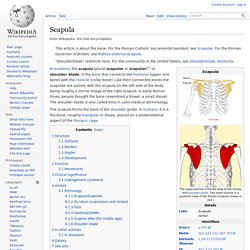
Like their connected bones the scapulae are paired, with the scapula on the left side of the body being roughly a mirror image of the right scapula. In early Roman times, people thought the bone resembled a trowel, a small shovel. The shoulder blade is also called omo in Latin medical terminology. The scapula forms the back of the shoulder girdle. In humans, it is a flat bone, roughly triangular in shape, placed on a posterolateral aspect of the thoracic cage. Coracoid process. "Coracoid" in itself means "like a raven's beak", with reference to its shape.

(Greek "Korax" = Raven) Structure[edit] The coracoid process is a thick curved process attached by a broad base to the upper part of the neck of the scapula; it runs at first upward and medialward; then, becoming smaller, it changes its direction, and projects forward and lateralward. Lateral border of the scapula. The lateral border (or axillary border, or margin) is the thickest of the three borders of the scapula.
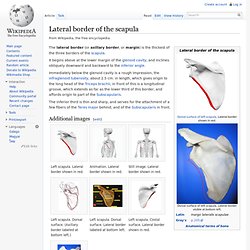
It begins above at the lower margin of the glenoid cavity, and inclines obliquely downward and backward to the inferior angle. Immediately below the glenoid cavity is a rough impression, the infraglenoid tuberosity, about 2.5 cm. in length, which gives origin to the long head of the Triceps brachii; in front of this is a longitudinal groove, which extends as far as the lower third of this border, and affords origin to part of the Subscapularis. The inferior third is thin and sharp, and serves for the attachment of a few fibers of the Teres major behind, and of the Subscapularis in front. Medial border of scapula. The medial border of the scapula (vertebral border, medial margin) is the longest of the three borders, and extends from the superior to the inferior angle.
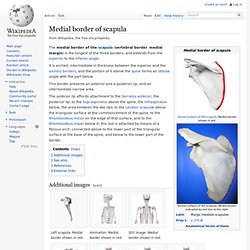
It is arched, intermediate in thickness between the superior and the axillary borders, and the portion of it above the spine forms an obtuse angle with the part below. This border presents an anterior and a posterior lip, and an intermediate narrow area. Inferior angle of the scapula. The inferior angle of the scapula is formed by the union of the medial and lateral border of the scapula and is the lowest part of the scapula.
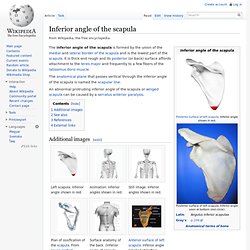
It is thick and rough and its posterior (or back) surface affords attachment to the teres major and frequently to a few fibers of the latissimus dorsi muscle. The anatomical plane that passes vertical through the inferior angle of the scapula is named the scapular line. An abnormal protruding inferior angle of the scapula or winged scapula can be caused by a serratus anterior paralysis. Additional images[edit] Spine of scapula. The spine of the scapula or scapular spine is a prominent plate of bone, which crosses obliquely the medial four-fifths of the scapula at its upper part, and separates the supra- from the infraspinatous fossa.
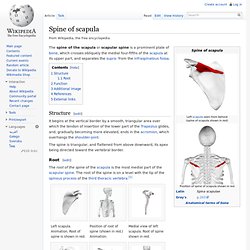
Structure[edit] It begins at the vertical border by a smooth, triangular area over which the tendon of insertion of the lower part of the Trapezius glides, and, gradually becoming more elevated, ends in the acromion, which overhangs the shoulder-joint. The spine is triangular, and flattened from above downward, its apex being directed toward the vertebral border.
Root[edit] Acromion. Structure[edit] The acromion forms the summit of the shoulder, and is a large, somewhat triangular or oblong process, flattened from behind forward, projecting at first lateralward, and then curving forward and upward, so as to overhang the glenoid cavity.[1] Surfaces[edit] Its superior surface, directed upward, backward, and lateralward, is convex, rough, and gives attachment to some fibers of the deltoideus, and in the rest of its extent is subcutaneous.
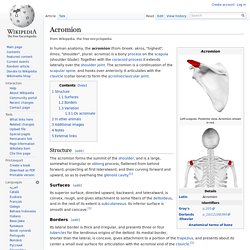
Its inferior surface is smooth and concave.[1] Acromioclavicular joint. Clavicle. Structure[edit] The clavicle is a doubly curved short bone that connects the arm (upper limb) to the body (trunk), located directly above the first rib.
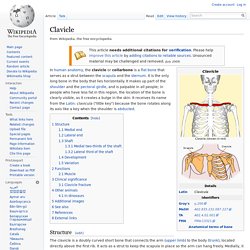
It acts as a strut to keep the scapula in place so the arm can hang freely. Medially, it articulates with the manubrium of the sternum (breast-bone) at the sternoclavicular joint. At its lateral end it articulates with the acromion of the scapula (shoulder blade) at the acromioclavicular joint. It has a rounded medial end and a flattened lateral end.
From the roughly pyramidal sternal end, each clavicle curves laterally and anteriorly for roughly half its length. It can be divided into three parts: medial end, lateral end and shaft. Medial end[edit] The medial end is quadrangular and articulates with the clavicular notch of the manubrium sterni to form the sternoclavicular joint. It gives attachments to: fibrous capsule joint all aroundarticular disc superoposteriorlyinterclavicular ligament superiorly Lateral end[edit] Shaft[edit] Fractures. Sternoclavicular articulation. The sternoclavicular articulation is structurally classed as a synovial double-plane joint and functionally classed as a diarthrotic joint.

It is composed of two portions separated by an articular disc which is made from fibrocartilage. Human sternum. The sternum (from Greek στέρνον, sternon, "chest"; plural "sternums" or "sterna") or breastbone is a long flat bony plate shaped like a capital "T" located anteriorly to the heart in the center of the thorax (chest).
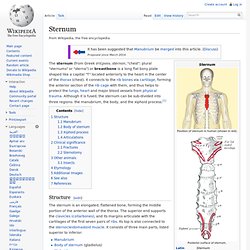
It connects to the rib bones via cartilage, forming the anterior section of the rib cage with them, and thus helps to protect the lungs, heart and major blood vessels from physical trauma. Supraspinatous fossa. The supraspinatous fossa (supraspinatus fossa, supraspinous fossa) of the posterior aspect of the scapula is smaller than the infraspinatous fossa, concave, smooth, and broader at its vertebral than at its humeral end. Its medial two-thirds give origin to the Supraspinatus. References[edit] This article incorporates text from a public domain edition of Gray's Anatomy. See also[edit] Supraspinatus muscle. Infraspinatous fossa. The infraspinatous fossa (infraspinatus fossa, infraspinous fossa) of the scapula is much larger than the supraspinatous fossa; toward its vertebral margin a shallow concavity is seen at its upper part; its center presents a prominent convexity, while near the axillary border is a deep groove which runs from the upper toward the lower part.
The medial two-thirds of the fossa give origin to the Infraspinatus; the lateral third is covered by this muscle. Additional images[edit] Left scapula. Subscapular fossa. The costal or ventral surface of the scapula presents a broad concavity, the subscapular fossa. It provides an attachment for the subscapularis muscle. Additional images[edit] Left scapula. Subscapular fossa shown in red.Animation. Anterior view of left humerus. Bicipital Groove (intertubercular sulcus) Posterior view of left humerus.